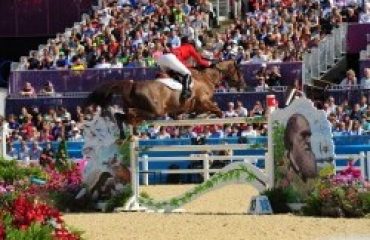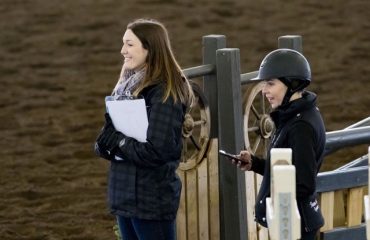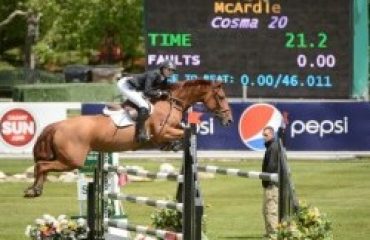 Richard Wheeler, DVM, was born in the U.K. and graduated from the Royal Veterinary College, London, in 2002. Dr. Wheeler then completed a two-year internship at Greenwood, Ellis and Partners (now Newmarket Equine Hospital) in Newmarket. In 2005, he moved to Wellington, Florida, to join Palm Beach Equine Clinic and he became a partner in 2009. Dr. Wheeler’s primary concentration is equine sports medicine. He is an FEI Veterinary Delegate for show jumping and dressage and has authored several published articles on the topic of equine sports medicine. Dr. Wheeler has served on the board of the USHJA Horse and Rider Advocates Committee. In 2016, Dr. Wheeler became a founding director of the Sport Horse Research Foundation. Dr. Wheeler and his wife, Jessica, have two children. Do you have a question you want Dr. Wheeler to answer? Send questions to editor@sidelinesnews.com.
Richard Wheeler, DVM, was born in the U.K. and graduated from the Royal Veterinary College, London, in 2002. Dr. Wheeler then completed a two-year internship at Greenwood, Ellis and Partners (now Newmarket Equine Hospital) in Newmarket. In 2005, he moved to Wellington, Florida, to join Palm Beach Equine Clinic and he became a partner in 2009. Dr. Wheeler’s primary concentration is equine sports medicine. He is an FEI Veterinary Delegate for show jumping and dressage and has authored several published articles on the topic of equine sports medicine. Dr. Wheeler has served on the board of the USHJA Horse and Rider Advocates Committee. In 2016, Dr. Wheeler became a founding director of the Sport Horse Research Foundation. Dr. Wheeler and his wife, Jessica, have two children. Do you have a question you want Dr. Wheeler to answer? Send questions to editor@sidelinesnews.com.
My neighbor is no longer able to care for her 20-year-old horse and has offered him to me. What sort of veterinary care does the horse need before I bring him onto my property to live with my horses?
First, it’s great that you are able and willing to take on this animal now that your neighbor is not able to care for him. There are several things to consider when moving any new horse to your property and some others specifically related to caring for a geriatric horse.
There are some questions that you should ask your neighbor or their veterinarian: Does the horse have a current negative Coggins test? What vaccinations has the horse received? What is the internal parasite program? When were the horse’s teeth last checked? And what is the horse’s current feeding regimen? It would also be valuable to know about any past medical problems or injuries that the horse has suffered.
I would recommend that you discuss the vaccination program with your veterinarian as this will vary between regions of the country. I would recommend a fecal test for internal parasites; you should also consider having a blood test for tapeworms done.
When specifically considering the geriatric horse, there are some other tests and factors that you should discuss with your veterinarian. Often, older horses will require more frequent dental attention, and if a dental examination has not been performed recently, one is advisable. A physical examination by your veterinarian may identify suspicion of metabolic conditions such as Cushing’s disease, which are often seen in older horses.
The act of introducing this new horse will depend on your situation, i.e. are the horses stabled or turned out together? Introducing a new horse to a group will need some careful planning and it can take some time for the horses to establish a new herd order. Moving a horse from your neighbor’s property is not likely to involve some of the issues faced when moving a horse across the country, such as change in climate, pasture or water source. Regardless, it will be important to keep the horse’s feeding regimen as consistent as possible and make any changes gradually.
My show jumping horse recently came up lame with swelling around the fetlock joint. How is an injury to the digital flexor tendon sheath diagnosed and what can be done to fix it?
The digital flexor tendon sheath (DFTS) is a synovial fluid-filled structure that houses the superficial and deep flexor tendons as they run over the back of the fetlock joint, i.e. from mid-cannon region to lower pastern. Some horses may have mild distension of the DFTS, which is benign and often referred to as “wind-puffs.” Injury to the DFTS is frequently seen in show jumping horses and characterized by more pronounced distension and lameness; the condition is known as tenosynovitis.
Diagnosis can be achieved by diagnostic local analgesia, usually directly into the sheath, followed by diagnostic imaging techniques. Typically, an ultrasound exam is performed and radiographs are taken. This can be a frustrating area to image, and a specific diagnosis is often not possible with these modalities. In some cases, MRI and CT can offer further information.

The view seen during tenoscopy of the digital flexor tendon sheath of a grand prix show jumper at Palm Beach Equine Clinic. Both smooth normal tendon surface and torn tendon fibers are seen. Photo by Palm Beach Equine Clinic
In my experience, the gold standard diagnostic tool is tenoscopy, a surgical technique where an arthroscopy camera is inserted into the tendon sheath. The surgeon has a very clear view of the sheath, tendons and supporting structures such as the manica flexoria. Often surgeons will find tears along the margin of the deep digital flexor tendon or the supporting structures can be injured. Tenoscopy offers the opportunity to debride (or clean up) the injuries and injured tissues can be removed. The surgeons at Palm Beach Equine Clinic have performed this procedure for many years and we have seen many excellent outcomes. The surgery can be coupled with or followed up by regenerative therapies such as platelet-rich plasma (PRP) and/or stem cells. In mild cases, without tendon injury, it’s possible to resolve inflammation with a corticosteroid injection; however given the difficulty of accurate diagnosis, I believe tenoscopy is the best option if rest doesn’t resolve the issue.
My horse’s eye has been running and she has been squinting. What are common eye problems in horses?
Eye problems in a horse should never be ignored, and as a horse owner it’s important to know the common signs of eye problems: squinting, tearing and changes in color. The eye is a complex organ and disease can occur in many areas. These clinical signs can be present with many ocular diseases involving both the globe itself and the surrounding tissues such as the eyelids and the conjunctiva.
With any eye problem, I would recommend an examination by your veterinarian; don’t wait to make an appointment. A simple eye exam will detect most common diseases, and if further tests are needed, a veterinary ophthalmologist can be brought in to help.
When presented with an eye problem, we like to examine the horse in low light. We inspect the bony casing around the eye, the eyelids, the cornea and look into the eye using an ophthalmoscope. If we are concerned about the cornea, we may use stains to look for damage to the eye surface, and in other cases, a tonometer can be used to measure the pressure within the eye.
In clinical practice, we commonly treat eyelid lacerations, conjunctivitis and minor scratches to the surface of the eye. In most cases, treatment is simple and the outcome excellent, but without rapid, appropriate therapy, these simple problems can quickly become severe. Bacterial and fungal infections can rapidly develop, prolong treatment and reduce the likelihood of a favorable prognosis. In South Florida, we have seen a rapid increase in the incidence of habronemiasis or ‘summer sores.’ This parasitic condition can also cause ocular disease, and I believe this will become an increasing problem in the United States.
Less common conditions of the equine eye include glaucoma, cataracts, uveitis and neoplasia. The clinical signs for these are often similar to the more common equine ocular diseases. Equine recurrent uveitis, commonly known as “moon blindness,” is a chronic inflammatory condition of the eye that will require ongoing treatment. These conditions often have similar presenting signs to the more routine eye problems. The take-home message should be that any eye problem should be treated as an emergency and immediately seen by a veterinarian.













